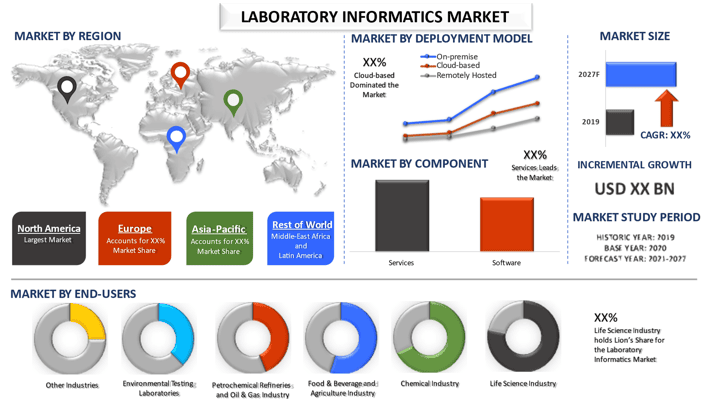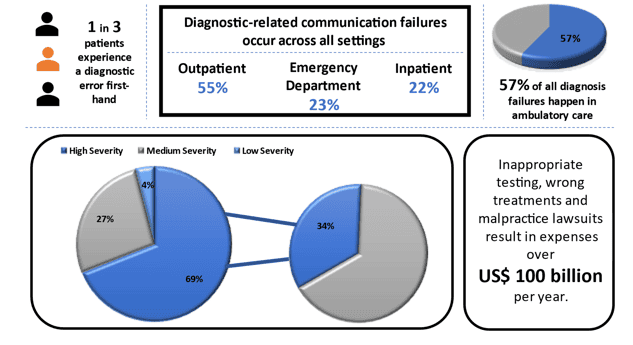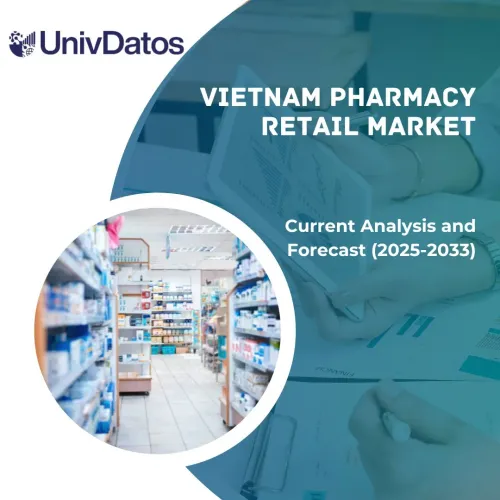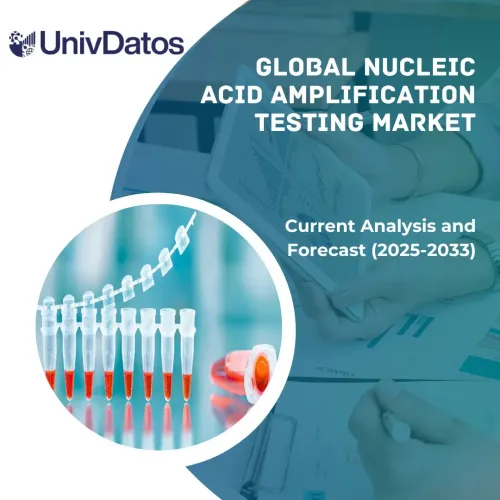- Home
- About Us
- Industry
- Services
- Reading
- Contact Us
Laboratory Informatics Market: Current Analysis and Forecast (2021-2027)
Emphasis on Type of Solution (Laboratory Information Management, Electronic Lab Notebooks, Scientific Data Management System, Laboratory Execution Systems, Electronic Data Capture & Clinical Data Management Systems, Chromatography Data Systems, Enterprise Content Management); Deployment Model (On-Premise, Cloud-Based, Remotely Hosted); Component (Services, Software); End-Users (Life Science Industry, Chemical Industry, Food & Beverage And Agriculture Industry, Petrochemical Refineries And Oil & Gas Industry, Environmental Testing Laboratories, Other Industries); Region/Country

Global Laboratory informatics Market is anticipated to grow with an elevated CAGR of around 9% over the forecast period (2021-2027). The specialized application of information technology aimed at optimizing and extending laboratory operations is known as laboratory informatics. It helps in ensuring high quality and reliable data & results.
The data generated by the laboratories is enormous and has been rising dramatically owing to the rise in technological advancement in molecular genomics and genetic testing practices. This is because of the increase in genetics funding by the National Institute of Health in the United States from USD 9.8 billion in 2019 to USD 10.5 billion in 2020. Also, currently, around 30% of the world’s data volume is being generated by the healthcare industry and it has been anticipated that by 2025, the compound annual growth rate of data for healthcare will reach 36%. Therefore, to minimize the error rate in this huge bunch of data and to reduce data management costs, many laboratories are deploying LIMS.
Furthermore, the laboratory informatics market is anticipated to grow on account of the growing adoption of integrated healthcare systems including LIMS, the rise in the use of healthcare information technology (HCIT), the surge in the number of chronic diseases, and the government initiatives to promote the use of IT in healthcare. For example, the FDA is partnering with the Association of Public Health Laboratories, the Association of American Feed Control Officials (AAFCO), and the Association of Food and Drug Officials (AFDO) to help build an integrated laboratory system to advance the safety of food and animal feed.
Impact of Diagnostic Failures, U.S.
 McKesson Corporation, Cerner Corporation, Agilent Technologies, Thermo Fisher Scientific Inc., PerkinElmer Inc., Waters Corporation, Sysmex Corporation, LabWare Inc., Abbott Informatics Corporation, LabVantage Solutions Inc., are some of the prominent players operating in the laboratory informatics market. Several M&As along with partnerships have been undertaken by these players to facilitate customers with laboratory informatics.
McKesson Corporation, Cerner Corporation, Agilent Technologies, Thermo Fisher Scientific Inc., PerkinElmer Inc., Waters Corporation, Sysmex Corporation, LabWare Inc., Abbott Informatics Corporation, LabVantage Solutions Inc., are some of the prominent players operating in the laboratory informatics market. Several M&As along with partnerships have been undertaken by these players to facilitate customers with laboratory informatics.
Insights Presented in the Report
“Amongst Type of Solutions, laboratory information management segment holds the major share”
Based on the type of solutions, the laboratory informatics market is segmented into laboratory information management, electronic lab notebooks, scientific data management system, laboratory execution systems, electronic data capture & clinical data management systems, chromatography data systems, and enterprise content management. The laboratory information management segment accounted for the largest market share in 2020 it is estimated that it will exhibit the highest CAGR during the forecast period as these systems enables efficient management of the flow of samples and associated data to improve lab efficiency.
“Amongst Deployment Model, cloud-based segment holds the major share”
Based on the deployment model, the laboratory informatics market is segmented into on-premise, cloud-based and remotely hosted. The cloud-based segment occupied the major share of the laboratory informatics market in 2020 and it is expected to grow with substantial CAGR in the upcoming years as they provide high flexibility and are cost-effective for the end-users. Furthermore, the low cost of installation and the ability of this software to eradicate the need for in-house maintenance is also one of the prime factors contributing to the growth of this segment.
“Amongst Component, service segment holds the major share”
Based on component, the market is fragmented into services and software. In 2020, the service segment grabbed a considerable market share, and it is expected to grow at a significant CAGR during the forecast period. An increase in outsourcing of laboratory informatics management system solutions is one of the prominent reasons for the growth of this segment. Furthermore, many of the large pharmaceutical research labs do not have the appropriate resources and skillset required for the deployment of analytics so they outsource these services. However, the software segment is also anticipated to show lucrative over the forecast period owing to the availability of a huge number of technologically advanced software.
“Amongst End-Users, Life Science Industry segment holds the major share”
Based on end-users, the market is fragmented into the life science industry, chemical industry, food & beverage and agriculture industry, petrochemical refineries and oil & gas industry, environmental testing laboratories, and other industries. In 2020, the life science industry segment grabbed a considerable market share, and it is expected to grow at a significant CAGR during the forecast period. The growth of this segment is attributed to the growing popularity of laboratory informatics in life sciences industries for developing innovative products and improving product quality, and operational efficiency.
“North America represents one of the largest markets of laboratory informatics market”
For a better understanding of the market dynamics of the laboratory informatics market, a detailed analysis was conducted for different regions across the globe including North America (the U.S, Canada, and the Rest of North America), Europe (Germany, France, Spain, United Kingdom, Italy, and Rest of Europe), Asia-Pacific (China, India, Australia, Japan, and Rest of APAC), Rest of World has been conducted. North America constitutes a major market for the laboratory informatics market industry and generated revenue of USD XX Million in 2020 owing to strong healthcare infrastructure and growing adoption of automated solutions in the laboratories in the region.
Reasons to buy this report:
- The study includes market sizing and forecasting analysis validated by authenticated key industry experts
- The report presents a quick review of overall industry performance at one glance
- The report covers an in-depth analysis of prominent industry peers with a primary focus on key business financials, product portfolio, expansion strategies, and recent developments
- Detailed examination of drivers, restraints, key trends, and opportunities prevailing in the industry
- The study comprehensively covers the market across different segments
- Deep dive regional level analysis of the industry
Customization Options:
The global laboratory informatics market can further be customized as per the requirement or any other market segment. Besides this, UMI understands that you may have your own business needs, hence feel free to connect with us to get a report that completely suits your requirements.
Table of Content
Analyzing the historical market, estimation of the current market, and forecasting the future of global green chemicals were the three major steps undertaken to create and analyze the adoption of green chemicals across various segments in North America, Europe, Asia Pacific, & Rest of the world. Exhaustive secondary research was conducted to collect the historical market numbers and estimate the current market size. Secondly, to validate these insights, numerous findings and assumptions were taken into consideration. Moreover, exhaustive primary interviews were also conducted, with industry experts across the value chain of the green chemicals sector. Post assumption and validation of market numbers through primary interviews, we employed a bottom-up approach to forecast the complete market size. Thereafter, market breakdown and data triangulation methods were adopted to estimate and analyze the market size of segments and sub-segments the industry pertains to. Detailed methodology is explained below:
Analysis of Historical Market Size
Step 1: In-Depth Study of Secondary Sources:
Detailed secondary study was conducted to obtain the historical market size of the green chemicals through company internal sources such as annual reports & financial statements, performance presentations, press releases, etc., and external sources including journals, news & articles, government publications, competitor publications, sector reports, third-party database, and other credible publications.
Step 2: Market Segmentation:
After obtaining the historical market size of the green chemicals market, we conducted a detailed secondary analysis to gather historical market insights and share for different segments & sub-segments for major regions. Major segments included in the report are as product and application. Further regional & country-level analyses were conducted to evaluate the overall adoption of green chemicals in the global context.
Step 3: Factor Analysis:
After acquiring the historical market size of different segments and sub-segments, we conducted a detailed factor analysis to estimate the current market size of green chemicals. Further, we conducted factor analysis using dependent and independent variables like burgeoning global warming rates and global need for clean energy sources. Historical trends and their year-on-year impact on the market size and share in the recent past were analyzed. Demand and supply side scenario was also thoroughly studied.
Current Market Size Estimate & Forecast
Current Market Sizing: Based on actionable insights from the above 3 steps, we arrived at the current market size, key players in the global green chemicals market, and market shares of the segments. All the required percentage split, and market breakdowns were determined using the above-mentioned secondary approach and were verified through primary interviews.
Estimation & Forecasting: For market estimation and forecast, weights were assigned to different factors including drivers & trends, restraints, and opportunities available for the stakeholders. After analyzing these factors, relevant forecasting techniques i.e., bottom-up approach was applied to arrive at the market forecast to 2027 for different segments and subsegments across the major regions globally. The research methodology adopted to estimate the market size encompasses:
- The industry’s market size, in terms of value (US$) and the adoption rate of green chemicals across the major markets
- All percentage shares, splits, and breakdowns of market segments and sub-segments
- Key players in the green chemicals market in terms of services offered. Also, the growth strategies adopted by these players to compete in the fast-growing market.
Market Size and Share Validation
Primary Research: In-depth interviews were conducted with the Key Opinion Leaders (KOLs) including Top Level Executives (CXO/VPs, Sales Head, Marketing Head, Operational Head, and Regional Head, Country Head, etc.) across major countries. Primary research findings were then summarized, and statistical analysis was performed to prove the stated hypothesis. Inputs from primary research were consolidated with secondary findings, hence turning information into actionable insights.
Split of Primary Participants in Different Regions
Market Engineering
Data triangulation technique was employed to complete the overall market estimation and to arrive at precise statistical numbers of each segment and sub-segment of the global green chemicals market. Data was split into several segments & sub-segments post studying various parameters and trends in the areas of water depth, installation, and turbine capacity verticals.
The main objective of the Green Chemicals Market Study
The current & future market trends of green chemicals were pinpointed in the study. Investors can gain strategic insights to base their discretion for investments from the qualitative and quantitative analysis performed in the study. Current and future market trends determine the overall attractiveness of the market at a global & country level, providing a platform for the industrial participant to exploit the untapped market to benefit as a first-mover advantage. Other quantitative goals of the studies include:
- Analyze the current and forecast market size of green chemicals in terms of value (US$). Also, analyze the current and forecast market size of different segments and sub-segments
- Segments in the study include areas of product and application
- Defined analysis of the regulatory framework for the global green chemicals industry
- Analyze the value chain involved with the presence of various intermediaries, along with analyzing customer and competitor behaviors of the industry
- Analyze the current and forecast market size of the green chemicals for the major regions & countries
- Major regions studied in the report include North America, Europe, Asia Pacific, and Rest of World
- Company profiles of the green chemicals market players and the growth strategies adopted by them to sustain in the fast-growing market
Deep dive regional & country level analysis of the industry
Related Reports
Customers who bought this item also bought










